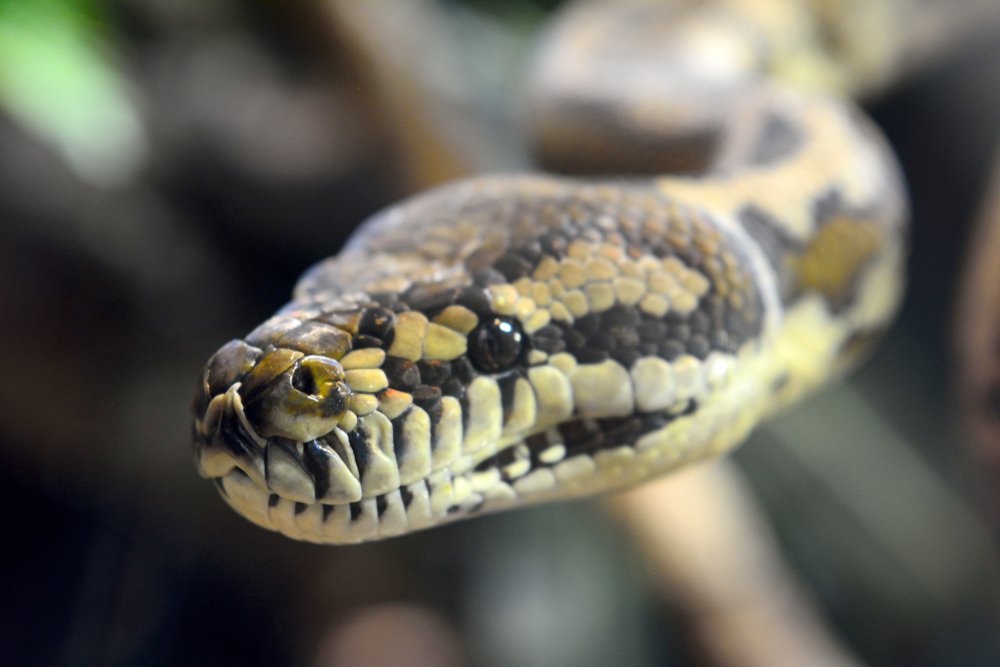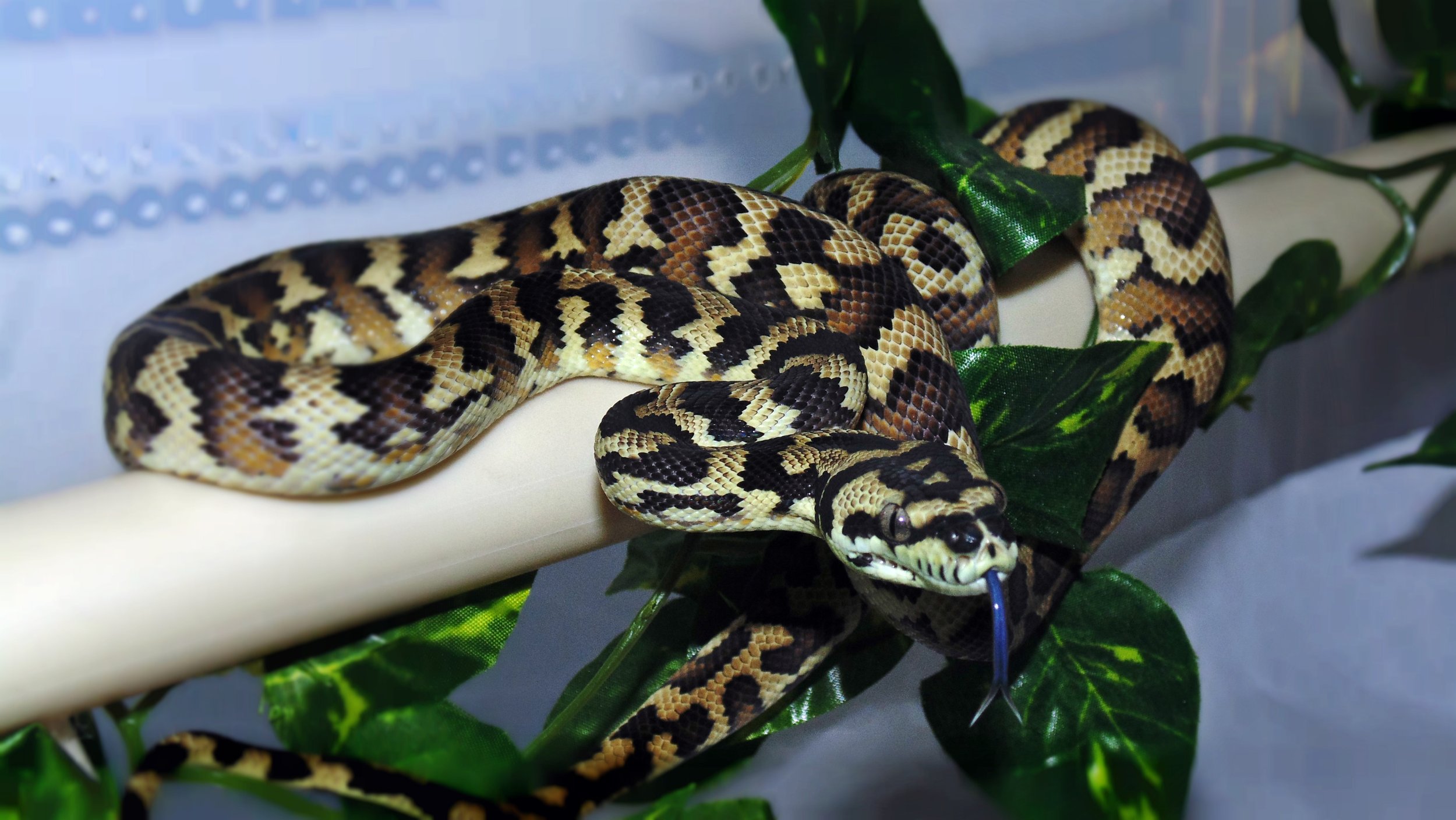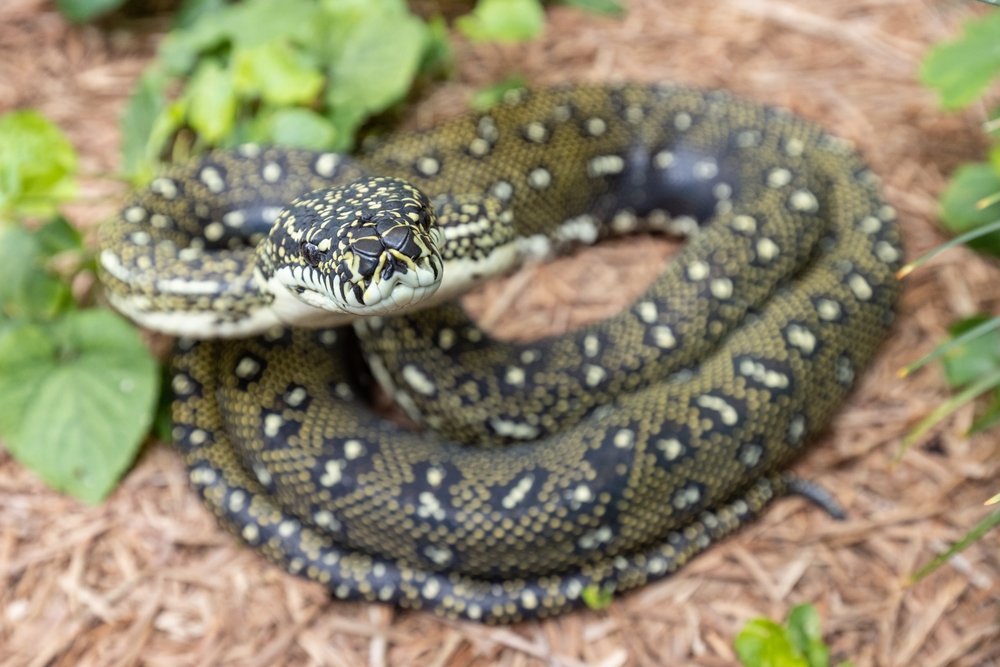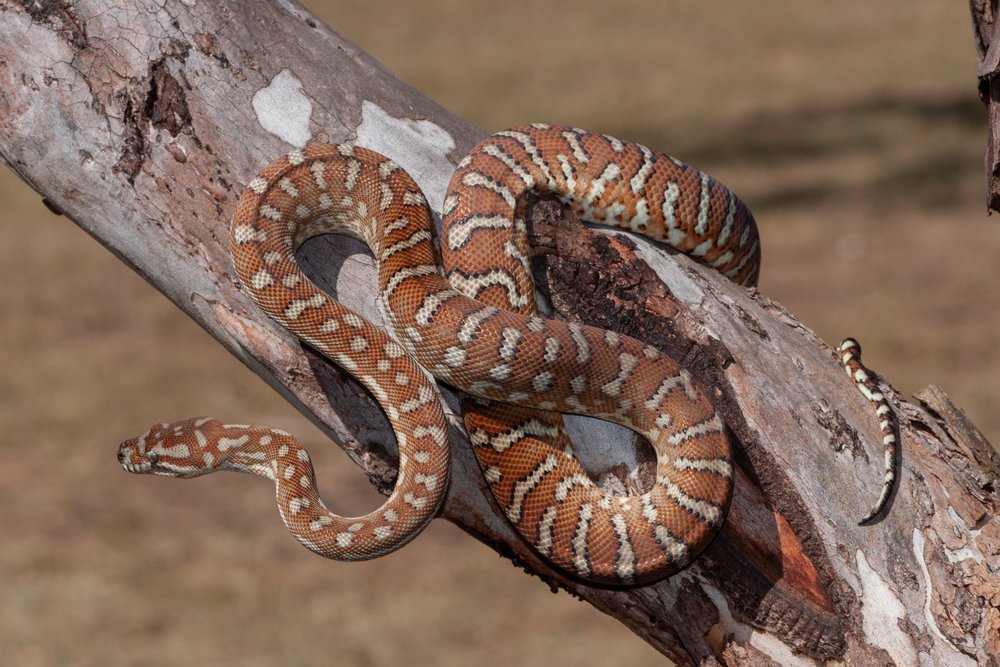Carpet pythons are some of the most diverse species of the entire Pythonidae family. Spread across a vast distribution of Australia and the Pacific, Morelia spilota ssp. are found in barren deserts, rich jungles and even suburban city locations. The natural history of each subspecies contrasts each other so greatly that the name ‘carpet python’ really does seem like a blanket term.
Jungle Carpet Python – (Morelia spilota cheynei)
As the name suggests, the jungle carpet python occupies a relatively small range of tropical forest in North Queensland. They are semi-arboreal and have the brightest colouration of any carpet python, contributing to their popularity in the hobby. Their restricted range is under threat from deforestation, as the urbanisation and growing agriculture of Australia’s East Coast continues to develop. Although the high yellow colouration often seen in captivity is accentuated by selective breeding, these carpet pythons are much more visually striking than other species. This has led a whole spectrum of colour morphs to be bred within the hobby. They also grow to a manageable size (three to five feet) but typically exhibit more arboreal traits than other species.


Darwin Carpet Python (Morelia spilota variegata)
The Darwin carpet python gets its name from the Northern Territory’s capital city where the species appears to be doing extremely well. As human inhabitants encourage various possums and rodents to feed on, the Darwin carpet python has adapted very well to the development of Australia’s Top End. Unsurprisingly, this snake can also be found throughout the north of Australia from the Kimberleys all the way towards the Cape York Peninsula. This landscape is much more arid, but seasonal rains mean the gorges and canyons that these snakes are found are often rich with vegetation. Interestingly, there are now a number of albino Darwin carpet pythons within the hobby. The first albino Darwin carpet python was found in the 90s at a caravan park just outside of Darwin. Misidentified as an illegal corn snake, this specimen was taken to the Territory Wildlife Park where it was identified as an albino and named ‘Blondie’. After being sent on breeding loan to Dr Simon Stone in Adelaide, the offspring of this snake now have a strong presence in herpetoculture across the world.

Morelia spilota harrisoni (formerly synonymous with M. spilota variegata) – Irian Jaya carpet python
The Irian Jaya carpet python is the only subspecies that lives outside of Australia. Spread across both Indonesian and Papuan sides of New Guinea, the Irian Jaya carpet python typically inhabits dry savannah and eucalypt forests. This species is one of the more popular in the pet trade as regulated export quotas of wild animals has allowed for more genetic diversity in captivity. They are also one of the smaller subspecies, growing between 4-6 feet (males are usually smaller), adding to their appeal. It is also thought that the highly variable specimens that were exported from Irian Jaya over the last few decades could indicate that there are many subspecies to still be identified. Furthermore, their reputation as being aggressive is slowly being de-bunked making their viability as pets much more appealing.

Diamond Python (Morelia spilota spilota)
The diamond python is the most southernly occurring python in the world. A common sight in suburban locations as far south as Sydney, diamond pythons will opportunistically feed on chickens and small family pets, giving them a negative reputation amongst residents. Despite reaching 7 feet in length, these large pythons are some of the more docile of the carpet pythons. Just like other carpet pythons, they are sizeable without being heavy-bodied, filling a niche for pet owners looking for a large animal without the troublesome aspects of the ‘giant’ snakes. There are also two-colour variants, one with white spots, another with yellow. Just like other carpet pythons, they are nocturnal and relatively slow-moving this means they can live in attics and rafters undetected for long periods of time offering free pest control services to oblivious homeowners.


Coastal Carpet Python – (Morelia spilota mcdowelli)
The coastal carpet python has the second largest distribution of any carpet python species and can be found down almost the entirety of Australia’s East Coast. Despite such as vast range, this species was first described in 1984 and appears very similar to the diamond python. The coastal carpet python is the largest of the carpet pythons, easily growing up to 8 feet in length. This, combined with its distribution covering the vast majority of human-occupied Australia makes it the archetypal ‘carpet python’. Their large size has made them extremely desirable in the hobby and are readily available in the UK, US and Europe. Although considered a common species and often found in Brisbane CBD, the population has felt the effects of the rising cane toad populations which were introduced to Gordonvale, Queensland (the heart of the coastal carpet pythons range) in 1935. By 1937 almost the entire range of the coastal carpet python was affected by the poisonous cane toads, which when ingested would kill the snakes.

Honourable Mentions
With taxonomy being such a complicated field, there are a few species which were previously considered to be subspecies of the carpet python. Commonly referred to as the South-western carpet python, Morelia imbricata has recently been described as a species of its own. This species is near threatened due to the agricultural development of its range in Western Australia and South Australia. As this species occupies a large range, but returns to favourite resting spots throughout its lifetime, the urbanisation of Perth, Esperance and Geraldton has contributed significantly to its decline. Needless to say, this species is almost unheard of in private collections.
The Bredl’s python on the other hand, is growing in popularity in the pet trade. Previously referred to as the Centralian carpet python, Morelia bredli can be found in the red centre of Australia. As such, this species has stunning red and orange colouration in mottled patterns. Coming from such a harsh environment, with daytime temperatures reaching in excess of 40°C and night time temperatures dropping drastically, the Bredl’s python is one of the hardiest python species on the planet. Enthusiasts also speak very highly of their docile nature, making them a brilliant alternative to the carpet pythons.

Keeping Carpet Pythons
The dominant literature around keeping carpet pythons largely groups all subspecies together. While there should be clear differences in the humidity of the environments of some species; temperatures, setups, and enclosures are usually very similar.
The jungle, Irian Jaya and coastal carpet pythons will typically inhabit more humid environments than diamond and Darwin carpet pythons. However, with Darwin being a tropical city North of the Capricorn, humidity levels rise drastically during the wet season. Since the Bredl’s python being considered its own species, most carpet pythons can be kept in similar conditions.
While some species are more arboreal than others (namely the jungle and Irian Jaya), all carpet python species should be provided with ample space to climb. Their nocturnal nature can be misleading within a captive environment, as these animals will do the majority of their environmental exploration out of sight. Therefore, providing the largest vivarium possible is encouraged. Each species will have slightly different requirements, with some growing much larger than others. Temperatures should be kept between 26°C and 28°C with a spot reaching around 36°C.
Humidity should be kept around 65%. There is some experimentation potential here to simulate the seasonality of tropical North Australia. Equally, humidity can drop drastically during the dry season, with some experts allowing their carpet python enclosures to drop to 35% humidity. Using orchid bark, or other humidity-retaining substrates is encouraged to help control humidity where it is required.
Climbing opportunities are crucial to providing environmental enrichment for the animals. Having multiple platforms and levels which give the snake enough room to rest its entire body is key to ensuring a happy snake. UVB is always encouraged regardless of an animals nocturnal or crepuscular activity. Research suggests there should be some variation with Ferguson zones between species. For example, diamond pythons (M. s. spilota) require zone 3 UVB lighting as they are typically more terrestrial than other species and inhabit open grasslands, whereas the Irian Jaya carpet python (M. s. harrisoni) would only require lighting between zones 1 and 2 as they spend much their time sheltered by the forest canopy.
Carpet pythons typically have a great feeding response which unfortunately plays into the negative stigma around their aggression. Youngsters are often quite snappy, but keepers with some experience with snakes can often find carpet pythons to be rewarding and enjoyable pets.
Enjoyed this feature? Sign up to EK for FREE here.

